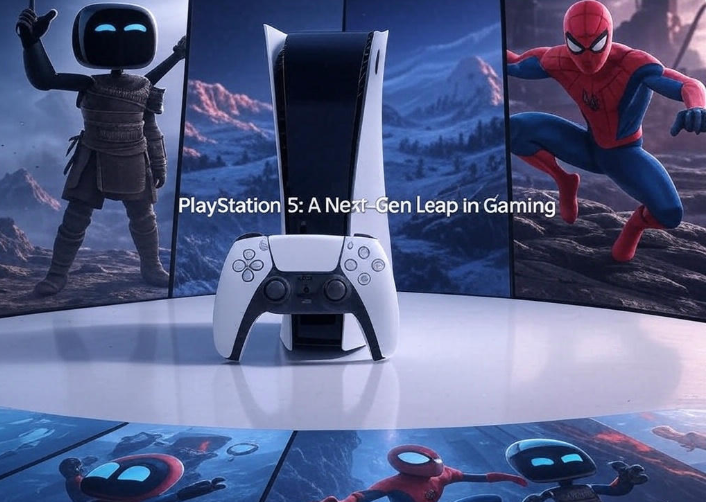Introduction
The Nvidia GeForce RTX 50-Series GPUs, unveiled at CES 2025, represent the latest evolution in Nvidia’s consumer graphics lineup, succeeding the RTX 40-Series. Powered by the Blackwell architecture, these GPUs promise significant advancements in AI-driven rendering, ray tracing, and overall performance for gamers, creators, and professionals. The series includes the flagship RTX 5090, RTX 5080, RTX 5070 Ti, RTX 5070, RTX 5060 Ti, and RTX 5060, each targeting different market segments. This review provides an in-depth analysis of the RTX 50-Series, covering design, performance, features, pricing, and real-world applications, based on available data and hands-on insights from industry sources.
Design and Build
Architecture: Blackwell
The RTX 50-Series is built on Nvidia’s Blackwell architecture, a shared platform for both consumer and data center products, manufactured using TSMC’s improved 4NP process node. Blackwell emphasizes high graphics frequencies, large L2 caches, and enhanced AI capabilities. Key hardware improvements include:
- Fourth-Generation RT Cores: These offer double the ray-triangle intersection rate compared to the RTX 40-Series, enabling more complex real-time ray tracing with reduced memory footprint through enhanced compression.
- Fifth-Generation Tensor Cores: These deliver up to 2.5x the AI processing power, critical for DLSS 4 and other neural rendering tasks.
- GDDR7 Memory: The entire series adopts GDDR7 memory, providing up to 1.8TB/s bandwidth with speeds reaching 30Gbps, a significant upgrade over the GDDR6/GDDR6X used in prior generations.
- PCIe 5.0 and DisplayPort 2.1b: Support for PCIe 5.0 ensures future-proof connectivity, while DisplayPort 2.1b UHBR20 (80Gbps) supports 8K displays at 165Hz.
Physical Design
Nvidia’s Founders Edition cards maintain a premium aesthetic, with sleek designs praised by enthusiasts. Partner cards from ASUS, MSI, and PNY offer diverse cooling solutions, such as ASUS’s quad-fan ROG Astral series and liquid-cooled variants for quieter operation. However, the adoption of the 12V-2×6 power connector (a revision of the 12VHPWR) has sparked concerns due to reports of melting cables on some RTX 5090 and RTX 5080 units, suggesting potential quality control issues.
Power Efficiency
Blackwell’s efficiency-focused design includes Advanced Power Gating, allowing unused chip sections to enter low-power states. This is particularly impactful for laptops, where Max-Q technologies like Low Latency Sleep and Accelerated Frequency Switching improve battery life by up to 40% compared to the RTX 40-Series. Desktop GPUs, however, require substantial power, with the RTX 5090 demanding a 1000W PSU, raising concerns for users with older systems.
Performance
Gaming Performance
The RTX 50-Series leverages Nvidia’s DLSS 4, which introduces Multi Frame Generation (MFG), generating up to three additional frames per rendered frame for up to 8x frame rate boosts in supported titles. Performance highlights include:
- RTX 5090: Marketed as 2x faster than the RTX 4090, it excels in 4K gaming with ray tracing and DLSS 4, delivering cinematic visuals. Benchmarks show it achieves triple-digit frame rates at 4K in titles like Cyberpunk 2077 and Horizon Forbidden West. However, its raw performance uplift is closer to 15-20% without DLSS 4.
- RTX 5080: Offers twice the performance of the RTX 4080 but falls short of the RTX 4090 in raw rasterization, with a 12-15% generational uplift.
- RTX 5070 Ti and 5070: The 5070 Ti provides less than 20% improvement over the RTX 4070 Ti, while the 5070 achieves a 23-25% boost over the RTX 4070. Nvidia’s claim that the RTX 5070 matches the RTX 4090 relies heavily on DLSS 4 MFG, which has drawn criticism for exaggerating real-world gains.
- RTX 5060 Ti and 5060: The RTX 5060 Ti (8GB and 16GB variants) and RTX 5060 ($299) target budget gamers. The 5060 Ti offers solid 1440p performance, with a 16GB model praised for future-proofing, but gaming performance on pre-release drivers was initially suboptimal.
While DLSS 4 significantly enhances frame rates, it generates 15 out of 16 pixels, raising debates about “fake frames.” Critics argue that MFG increases latency in fast-paced games, though Nvidia Reflex 2 mitigates this by reducing latency by up to 75%. Approximately 75 AAA titles, including Indiana Jones and the Great Circle, support DLSS 4 at launch.
Compute and Creative Performance
The RTX 50-Series excels in creative workflows, with the RTX 5090’s 32GB VRAM enabling complex 3D rendering and video editing. The ninth-generation NVENC encoder supports 4:2:2 color format and AV1 Ultra High Quality mode, offering 5% better compression and 60% faster video exports compared to the RTX 4090. FP4 quantization reduces memory demands for AI models like FLUX.1, allowing the RTX 5090 to generate images in 5 seconds versus 15 seconds on the RTX 4090.
Linux Compute Performance
Under Linux, the RTX 5060 Ti demonstrated strong OpenCL and CUDA performance with the NVIDIA 570.133.07 driver, though initial gaming performance was limited by non-optimized drivers. Compute benchmarks suggest the RTX 50-Series is a viable choice for developers and researchers.
Features
DLSS 4 and Neural Rendering
DLSS 4 is the cornerstone of the RTX 50-Series, combining Super Resolution, Ray Reconstruction, and Multi Frame Generation. Unlike DLSS 3, MFG is exclusive to RTX 50-Series GPUs, limiting its benefits to new adopters. Neural Shaders enhance visual fidelity, making games appear more immersive. However, the heavy reliance on AI-generated frames has sparked criticism for masking modest raw performance gains.
RTX Remix and NVIDIA Studio
RTX Remix enables modders to remaster older games with ray tracing and DLSS, while NVIDIA Studio accelerates creative apps like Adobe Premiere Pro and DaVinci Resolve. AI-powered tools, such as RTX Video Super Resolution and NVIDIA Broadcast, enhance video playback and livestreaming, reducing GPU usage by 30%.
Driver Stability
The 572.XX driver branch for RTX 50-Series has faced criticism for instability, affecting RTX 30 and 40-Series GPUs. Issues include blackscreen errors and crashes, with Nvidia promising fixes in future updates.
Pricing and Availability
Pricing for the RTX 50-Series is a contentious topic, with MSRPs lower than expected for most models but marred by scalping and stock shortages:
- RTX 5090: $1,999 (desktop), $2,899+ (laptops). Scalpers have driven prices to $4,500 on eBay.
- RTX 5080: $999 (desktop), $2,199+ (laptops).
- RTX 5070 Ti: $749 (desktop), $1,599+ (laptops).
- RTX 5070: $549 (desktop), $1,299+ (laptops).
- RTX 5060 Ti: $379 (8GB), $429 (16GB).
- RTX 5060: $299, launching in May 2025.
Availability remains a challenge, with RTX 5090 and 5070 Ti stocks depleting rapidly. European markets have seen price dips due to favorable exchange rates, but U.S. consumers face inflated prices.
Pros and Cons
Pros
- DLSS 4 Excellence: Multi Frame Generation delivers unmatched frame rates in supported games.
- Future-Proof Features: GDDR7, PCIe 5.0, and DisplayPort 2.1b ensure longevity.
- Creative Performance: Ideal for 3D rendering, video editing, and AI workloads.
- Efficiency in Laptops: Advanced Power Gating enhances mobile gaming.
Cons
- Modest Raw Performance Gains: 12-25% uplift without DLSS 4 is underwhelming for some models.
- Pricing and Scalping: High costs and stock shortages deter budget-conscious buyers.
- Power Connector Issues: Melting 12V-2×6 cables raise reliability concerns.
- Driver Instability: Early driver issues affect performance and stability.
Real-World Applications
Gaming
For 4K gamers, the RTX 5090 and 5080 are top choices, delivering smooth performance in ray-traced titles. The RTX 5070 and 5060 Ti cater to 1440p and 1080p gamers, respectively, with the 16GB RTX 5060 Ti offering excellent value for budget builds.
Content Creation
Creators benefit from the RTX 5090’s 32GB VRAM and NVENC enhancements, making it a powerhouse for video editing and 3D modeling. Lower-tier models like the RTX 5070 Ti are sufficient for less demanding tasks.
Laptops
RTX 50-Series laptops, available from March 2025, combine Blackwell GPUs with Intel and AMD CPUs. The Razer Blade 16 with RTX 5090 impressed in tests, offering desktop-like performance in a slim chassis, though pricing starts at $2,899.
Comparison to RTX 40-Series
The RTX 50-Series offers incremental improvements over the RTX 40-Series, with DLSS 4 and GDDR7 as key differentiators. However, the RTX 4080 and 4090 remain competitive for 1440p and 4K gaming, especially at discounted prices ($649 for RTX 4070 Super). Users with RTX 4070 or higher may not need to upgrade unless targeting DLSS 4-exclusive features.
Consumer Sentiment
Posts on X reflect mixed sentiment. Enthusiasts praise the RTX 5060 Ti’s value and performance, with reviews from @RedGamingTech and @ZOTAC_UK highlighting its 1440p prowess. However, skepticism surrounds Nvidia’s performance claims, with @grok noting only 3-8% gains in synthetic benchmarks for RTX 5080 and 5070.
Conclusion
The Nvidia GeForce RTX 50-Series GPUs push the boundaries of AI-driven gaming and creative performance, with DLSS 4 and Blackwell’s architectural advancements setting a new standard. The RTX 5090 is a flagship masterpiece for 4K enthusiasts and creators, while the RTX 5060 Ti and 5070 offer compelling value for budget and mid-range builds. However, modest raw performance gains, high pricing, stock shortages, and early driver issues temper enthusiasm, making the series a mixed bag. For those with RTX 40-Series GPUs, the upgrade may not be justified unless DLSS 4 or specific creative needs are priorities. As driver updates and AMD’s RX 9000 series emerge, the RTX 50-Series’ value proposition will become clearer.
Recommendation: Ideal for high-end gamers and creators seeking cutting-edge AI features, but budget-conscious users should consider RTX 40-Series deals or wait for price stabilization.



